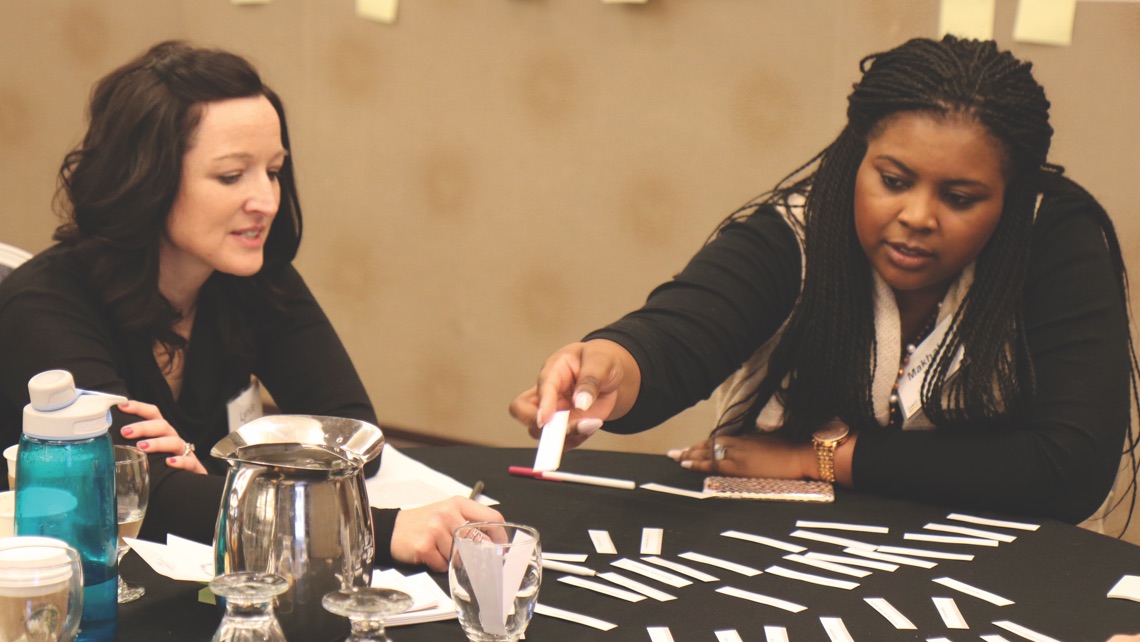Applying high-leverage practices and practice-based teacher education to improve the preparation of beginning teachers
“It felt pretty exciting right away,” said Susan Gonzowitz, founding managing director of East Harlem Teacher Residency (EHTR). “I thought the high-leverage practices make so much sense. Why haven’t we been thinking about this all along?”
Gonzowitz is one of more than 80 teacher education deans, professors, directors, and program officers from across the country who have collaborated with TeachingWorks as part of the Bill & Melinda Gates Foundation Teacher Preparation Transformation Centers Project. Since 2016, the foundation has supported TeachingWorks in providing professional learning, support, and resources focused on the teaching of the high-leverage practices to networks of teacher educators.
TeachingWorks collaborates with members of three teacher preparation centers for the project: the National Center for Teacher Residencies (NCTR), TeacherSquared, and the University-School Partnerships for the Renewal of Educator Preparation (US-PREP). Together, these organizations comprise more than 20 alternative and traditional teacher preparation programs from across the United States. Their collective goal in the collaboration is to apply both the high-leverage practices and practice-based teacher education pedagogies to improve their preparation of beginning teachers within their own contexts.
“Bringing these educators together enabled us to do deep work in developing a common language for training novice teachers,” said TeachingWorks Centers Project Director Anita Ravi. “We believe this work will have a significant impact in setting a new standard for entry to the teaching profession across the country.”
Over the past year, the bulk of the group’s work took place in three three-day-long cross-center convenings held in Detroit. During the convenings, TeachingWorks led participants through in-depth decompositions of multiple high-leverage practices, taking time to name and discuss key teaching moves within each practice that are integral to disrupting inequity and advancing justice in classrooms.
“We believe this work will continue to inspire collaboration across institutions from all over the country toward the improvement of teacher preparation.” Nicole Garcia, Chief Program Officer, TeachingWorks
According to Gonzowitz, EHTR, which is a member of NCTR, joined the Centers Project with the goal of improving preparation of their residents and to gain tools and knowledge to continue shifting their organizational model to embody anti-racism. Gonzowitz recalled when she first joined the collaboration, noting that learning about high-leverage practices, and how each can be leveraged to disrupt racism in classrooms, was most eye opening.
“We had worked so hard to ground our teacher training in evaluation systems, but we had never really stepped back and asked ourselves to consider what the key things were that we should teach our residents to do in their pre-service year that would have long-lasting and positive impact,” she said. “Learning about the high-leverage practices, especially about how enacting them poorly can reinforce injustice and harm children, was really powerful.”
In addition to working as a whole group to decompose the practices, participants worked in smaller groups to learn and try out ways of teaching the high-leverage practices in specific content areas. These breakout sessions were led by TeachingWorks research and design specialists in English language arts, mathematics, science, and social studies.
TeachingWorks designed these sessions to be deeply engaging. Participants had opportunities to take turns role-playing, using methods such as examining transcripts and videos and facilitating rehearsals for teaching the high-leverage practices to beginning teachers, all while receiving coaching and feedback from TeachingWorks staff members and other participants in the collaboration.
“Rather than just reading or talking about the practice, and looking at examples, we’re using this collaboration to learn and try out specific ways to set beginning teachers up to actually engage in using the high-leverage practices before they work with children in classrooms,” said TeachingWorks Chief Program Officer Nicole Garcia.
Participants in the Centers Project continue to receive support from TeachingWorks to develop plans for implementing the work they’ve done together within their own contexts. At East Harlem, Gonzowitz said she and her team successfully piloted a small set of high-leverage practices and are now shifting their entire residency program to fit a practice-based model.
“We’ve really been able to see how our residents are reflecting on, talking about, and showing growth in using the high-leverage practices,” she said. “This whole process has proven to us that practice-based methods are the best way for us to train our residents.”
Above all, the positive adjustments participants like Gonzowitz have made to their teacher preparation programs as a result of the collective work showcase the power of cross-center partnership.
“We don’t often as teacher educators get the chance to collaborate with each other in this way, to talk about our work, to try things out with each other, and to learn and grow,” Garcia said. “We believe this work will continue to inspire collaboration across institutions from all over the country toward the improvement of teacher preparation.”



